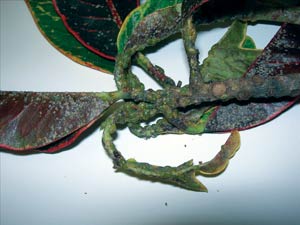8/1/2008
A New Croton Scale
Lynn Griffith

Most “new” insects in horticulture are actually infestations of insects already known in other parts of the world. For various reasons, an insect known for decades in, say, England may suddenly show up in a forest in Oregon. These pest migrations can happen via shipped plants; travelers bringing plants or fruits on their journeys; transfer by storms, birds, other animals, shoes or clothing of travelers and so forth. Many times, the actual means of movement of an insect pest are unknown.
On April 9, 2008, a scale insect was discovered on ornamental croton (
Codiaeum variegatum) in a nursery in the Florida Keys. Specimens submitted to university entomologists were originally tentatively identified as
Philephedra. This scale insect is not all that common, but at times infestations have resulted in nursery quarantines. Specimens of the croton scale were sent to various specialists around the world, including Dr. Chris Hodgson at the National Museum of Wales, England. Dr. Hodgson indicated that this new exotic scale insect did not fit into the genus
Philephedra, that it lacks an ovisac, and that it’s actually an undescribed species in an undescribed genus of unknown origin. In other words, this scale insect is completely new to science.
A couple of months ago, a homeowner brought into our lab some croton cuttings that clearly had a severe scale infestation. It was a type of scale I hadn’t seen before, so I carefully packaged it and sent it to the University of Florida for identification. Sure enough, it came back as the new, as-yet-unidentified-and-unnamed croton scale. As you can see from the picture, it is quite an aggressive scale insect, apparently developing large populations rather quickly.
Not much is known about the insect so far. Adult males are small, orange gnat-like insects. The host range so far includes primarily ornamentals and native plants from Florida. Besides croton, they include guava, strangler fig, mango, island marlberry and wild coffee. I suspect the host range will expand significantly with time. It has been found in about a dozen counties all over the Florida peninsula, from Jacksonville to the Keys. One report indicates the scale could have originated in Guatemala.
Growers should be very observant for scale insects on croton cuttings or plants brought into their facility from Florida. Check the undersides of the leaves carefully, as well as the stem tissue near the shoot tip, as that’s where the scale likes to proliferate. It’s easily noticeable with the naked eye.
Specific controls for the scale have not yet been established, but general scale insect controls include Distance, Flagship, Safari, horticultural oils and Tristar. If you see an unfamiliar scale-like insect on crotons from Florida, contact your grower and your local Department of Agriculture. Dr. Greg Hodges from the University of Florida is working on a formal description and name for the insect, which should be forthcoming before too long. New insect species are being described all the time, and this one just may have a small effect on our industry.
Lynn Griffith is president of A&L Laboratories, Pompano Beach, Florida.